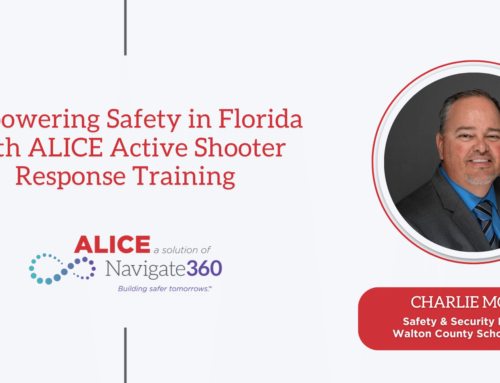
Situational awareness—being fully cognizant of your surroundings, the people in it, and your situation—is a vital factor for preventing and responding to an immediate threat to the school. The School Resource Officers (SRO) in your district are likely trained in the concept, but situational awareness is an important safety skill—and life skill—for all members of your staff. Recognizing, assessing, and responding to threats are critical first steps to surviving an active shooter incident.
ALICE Training®, a critical resource for improving school safety within your district, is a research-supported, proactive, option-based active shooter response training program that empowers individuals of all ages and abilities to participate in their own survival in the face of violence. Situational awareness training is at the core of the ALICE program because observations gathered can help inform individuals of which active response strategies can save their lives.
What Is Situational Awareness in Education?
Situational awareness in education means being aware of who (and what) is on school grounds. Most threats are man-made, so schools should always know who is on campus—from students and employees to vendors and visitors—and be able to identify anyone who is not supposed to be there or is behaving in a way that raises an internal alarm, e.g., displaying an angry or intense demeanor or wearing heavy clothing that is inappropriate for the weather. Suspicious objects, such as an unattended bag or unidentified vehicle that does not seem to belong, should also be assessed as a potential threat. An important lesson of situational awareness training is to take these notifications of danger seriously so you can make the best decision for responding should a threat erupt.
Situational awareness includes these three essential actions:
- Recognition – being alerted to something out of the ordinary that could pose a threat
- Assessment – analyzing the situation and your response options
- Response – taking direct action to increase the chance of survival
Situational awareness at school is best practiced by all members of the district, including SROs, school and district leaders, teachers, and other staff so that a comprehensive picture of all activity can be assessed for threats.
Situational Awareness & Threat Response Training in Schools
Though threats to school safety are rare, they do happen. And when an incident occurs, that dangerous situation is unique and requires an appropriate response. That is to say, there is no one-size-fits-all response to immediate danger. While lockdown drills serve a specific purpose, school districts that are practicing lockdown-only responses may actually be putting people at risk by conditioning out the natural flight instinct and confining them to a space where they could become easy targets. Lockdown-only strategies no longer meet the recommended threat-response of federal and state agencies.
ALICE Training® is built upon a multi-option response model that is supported by research and tailored to the individual needs of schools within your district. The program blends in-person and online training to provide your faculty, staff, and students with active response options that can help them make the best decision for the threat situation. The critical factor of ALICE’s multi-option response training is situational awareness, which directly supports the key actions of ALICE Training®.
How Situational Awareness Supports ALICE Training®
To illustrate the importance of situational awareness training, let’s review how it plays a role in each of the five essential responses of ALICE Training®, which can be used in any order: Alert, Lockdown, Inform, Counter, Evacuate.
Alert
Being fully aware of one’s surroundings is at the heart of situational awareness. Awareness includes recognizing suspicious persons or packages and knowing where the exits are inside a building. Alert is also about overcoming denial and accepting reality. If someone is behaving suspiciously or there’s a smell or sound that doesn’t feel right, it’s crucial to take the threat seriously to make the right survival decisions. A speedy response can save lives.
Lockdown
As noted above, lockdown-only threat responses are no longer the preferred method in active shooter incidents. However, enhanced lockdown is still a necessary tactic in certain situations, namely when the assailant is within the immediate vicinity, and evacuation is not possible. Situational awareness, as it applies to lockdowns, means knowing how the door to the room operates and locks and identifying nearby objects that can be used to barricade it.
Inform
Knowing exactly where the threat and communicating that information to others (when safe to do so) is vital to saving lives. For instance, if the shooter is known to be in a specific area of the building, occupants in another section can evacuate. Situational awareness also includes informing employees, law enforcement, and first responders of the violent incident, as outlined in the district’s emergency response plan.
Counter
Situational awareness training includes taking stock of objects that are within reach and can be used to thwart an attack. To be clear, Counter does not mean to directly confront the intruder. Rather, the goal is to create noise, movement, distance, and distractions to confound the shooter, break their concentration and make it harder for them to hit a target. Knowing what items are available and one’s own physical capabilities could provide a last-resort response option.
Evacuate
Be aware of all entry points to a building and what other non-traditional means of escape can be utilized in an emergency. Windows, for example, can be opened or broken—knowing how to properly break the glass (a valuable skill taught by ALICE Training®) may provide the best chance of escaping.
Situational Awareness & Other Safety Training to Empower Your School District
Situational awareness is a critical component of your district’s active threat response program. Discover the top ten must-haves for creating such a program by reading Navigate360’s ALICE Training® strategies guide. To learn more about the life-saving benefits of ALICE Training®, contact us today.






